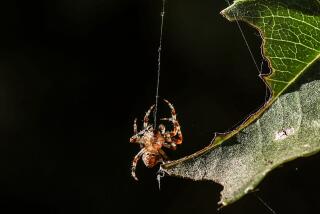Springtime for Rose Aphids
- Share via
IT IS ALREADY spring for them. On rosebushes around Southern California, they are starting to build the pyramid of life. One will become two; two will become four; four, eight; eight, sixteen, and on and on until the rosebuds are covered with a brick-pink pelt of velvety, succulent rose aphids.
In more scientific terms, they are becoming the first trophic level--the creatures that feed on plants--and that level will in turn become available to the second trophic level--the creatures that feed on them. Ladybird beetles and their voracious grubs, syrphid fly maggots, lacewings and their needle-jawed grubs, minuscule wasps that lay their eggs inside the aphids’ bodies--they will all slaughter and devour aphids by the multitudes. Being a rose aphid is not, to be literal, a “rosy” proposition.
Aphids, however, have a weapon that makes them invincible as a group: parthenogenetic birth. They conceive without fertilization, and so each conception is truly immaculate (during the winter, spring and summer, that is; later in the season they “switch” to the more traditional male-female strategy).
Each birth is a wonder to behold, because the offspring are born alive, like tiny calves. The mother stands on a rosebud or some succulent stem, sucking the juices with her pointed straw of a mouth embedded in the tissue--her long, slender antennae arched back over her body. She slowly tilts her abdomen upward. By and by, the little one appears, rear end first. Gradually, laboriously, it emerges between its mother’s cornicles, strange tubes that look like exhaust pipes. Finally, after 15 or 20 minutes, the mother lowers her abdomen, setting her infant on the plant. It totters a few steps and, now alongside its mother, also embeds its sucker in the plant. Even as it does, the embryo of its own offspring is already forming inside. Therefore, one will become two in just a few days, a countless multitude inside a month--a multitude whose place in the grand scheme is that of manufacturing food for others.






